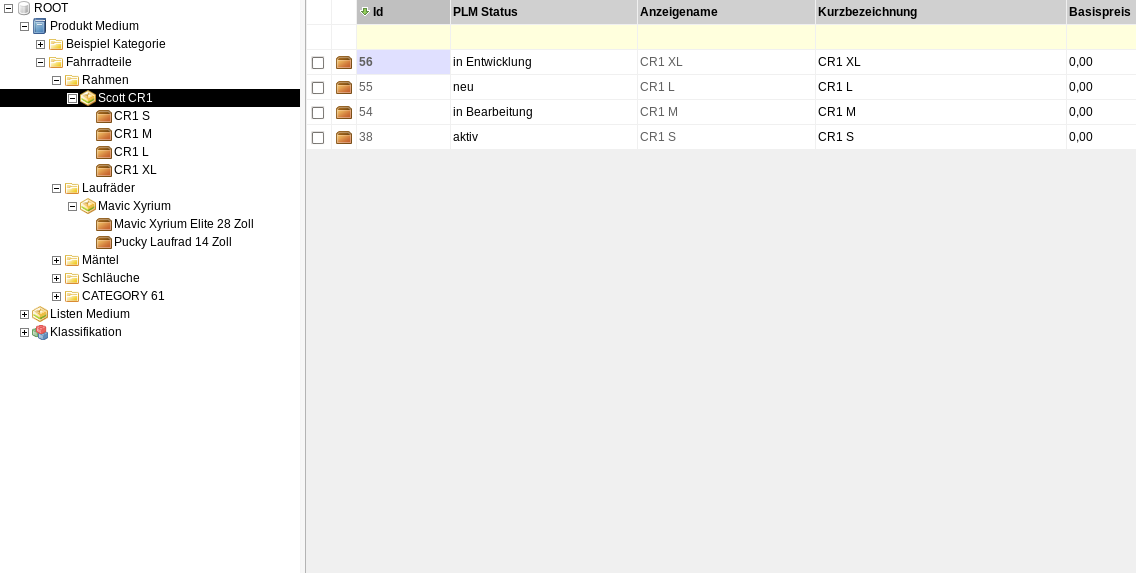Product Lifecycle Management in Alterra
With Alterra, you can effectively implement product lifecycle management (PLM) in your company. Sepia offers a special configuration of Alterra PIM, which clearly depicts the lifecycle of products. This initial configuration can be extended in a way that it covers exactly the needs of our company. Sepia offers consulting as well as all necessary implementation services.
What is Product Lifecycle Management (PLM)?
Product Lifecycle Management (PLM) governs a company's planning and management processes to control the lifecycle of products and product data. It may cover all stages of the product lifecycle. The processes involved reach from product conception to planning, design, production, marketing and sales to archiving product data. In some cases, these processes even include the recycling of the product.
Product lifecycle
The lifecycle of a product consists of the successive stages of a product's life. It begins with product development and usually ends with the disposal of the product. Each stage of this cycle can be divided into processes.
Example: Simplified PLM process for accessories and spare parts
- Market analysis and model analysis
- Identify and assign appropriate products to models
- Identify still uncovered models for the spare part Development / production order
- Status: Product in development, BOL (Beginning of Life)
- Status: Product available
- Status: Product expiring
- Supporting process: Return and recycling
- Status: Product EOL (End of Life)
- Status: Archiving of product information
PLM software
PLM systems implement the functions and processes that are defined by PLM planning. PLM systems allow the use of a common master data base. The concept of joint development, joint marketing and sales and order processing is effectively implemented by simultaneous data access of the parties involved in the product process. This synchronized approach reduces or completely avoids data redundancy over the product lifecycle.

Screenshot: Example – graphical user interface of PIM software implementing PLM-functions (Sepia Alterra PIM)
How PLM software works
Master data management
Master or core data management is at the heart of the capabilities of any PLM software. Here, the functions used to manage product data are provided.
Function deployment
In the development stage of a product, functions are required that allow the generation of data and information on the product.
Process management
Process management offers functions that enable the optimization of the processes of an organization. System integration then allows consolidating the functions that enable the exchange of data between different software solutions such as, for example, so-called enterprise service buses (ESBs).
Benefits of software-based PLM
General benefits
-
Fast and efficient data access by all departments
-
Avoiding data inconsistencies
-
Ensuring the integrity and up-to-dateness of the data inventory
-
Purposeful change management
-
Mapping the complexity of products and their relationships to other objects
-
Reducing the variety of parts
-
Complying with standards within the organization
-
Support of distributed teams
-
Implementing quality assurance measures
Benefits of PLM by departments
Development
Optimized product and process design
Efficient search for information
Manufacturing
Reduction of complexity by fewer components
Lower launching costs through more transparency
Marketing and sales
Transparency within the product and service portfolio
High efficiency and therefore high customer loyalty
Service
Controlled product properties over the entire lifecycle of a product.
Improved access to product data and improved knowledge management.
Potential benefits of PLM for companies
The potential benefits of PLM depend, of course, on the general conditions existing within a company and in the market, in which a company operates. To fully use the potential offered by PLM it is crucial to identify the areas / departments and processes within the company where the introduction of PLM would result in time and cost savings.
Conclusion
There is no doubt that the coordinated use of lifecycle-relevant data within a company has the potential to deliver huge increases in effectiveness. Therefore, the use of PLM can ultimately increase the competitiveness of manufacturing companies significantly.
Contact
Sepia GmbH & Co. KG
Ernst-Gnoss-Strasse 22
D-40219 Düsseldorf - Germany
Phone: +49 211 51 419 75
Phone alternative: +49 211 74 958 712 0
E-Mail: info@sepia.de
Looking for consultation or a web demo?
Get it here.
